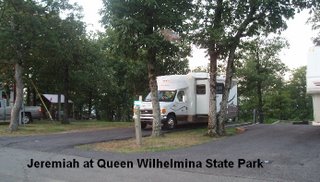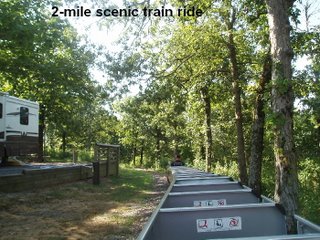Another amazing Arkansas State Park

August 13 and 14, 2006
Here’s what the brochure has to say about Queen Wilhelmina State Park:
“High atop Arkansas's second tallest peak, this cloud-capped hideaway reigns above the Ouachita Mountains. Located on the Talimena Scenic Drive, the park is as rich in history as in scenery. In the late 1800s, a resort lodge was built on Rich Mountain by the Kansas City, Pittsburgh and Gulf Railroad. It was named Queen Wilhelmina Inn in honor of the Queen of the Netherlands. Two inns have replaced the original "Castle in the Sky"--the latest is this park's focal point. The lodge offers 38 guest rooms including two Queen's Rooms with wood-burning fireplaces, two Regent's Rooms with spa tubs, and the Stilwell Room with a king-size bed and sitting area. Enjoy shopping in the Queen's Treasury gift shop and dining on delicious Southern cuisine in the Queen's Restaurant.”
Rich Mountain is the second highest mountain in Arkansas – 3,000 feet.
The drive up highway 88 was steep and winding – and a motorcyclist’s dream ride. (Note to Bonnie and friends on Palomar Mountain: perhaps you should put the word out about highway 88 in western Arkansas so those nuisance riders on SR6 and SR7 go elsewhere!)
It is such an amazing place I wish I could stay longer. The RV sites are less spacious, but there’s a lot to see and do. About noon today I’ll head west into Oklahoma, but first there are things to see and do.
The lodge was built at the turn of the century, restored by the state of Arkansas in 1962, and then rebuilt again after a devastating fire in 1975. The view from right outside the lodge was spectacular.

There’s also the Rich Mountain Scenic Railroad that started in 1960. The engine is painted the same color as the original Southern Belle of the Kansas City Southern Railroad. I was at the station at 9 a.m. and asked the engineer when the first ride would be. He answered “Whenever someone wants to ride.” “Here I am!” I said. For $3 I was the only passenger for the two-mile ride around part of the park.

Another interesting feature of this state park is the zoo/refuge that takes in injured wildlife for treatment and rehabilitation. It’s a home-grown operation run by a local man on a non-profit basis. All the money from donations and entrance fees ($4/person) go towards the animals’ upkeep and medical bills. The man and his wife both have regular jobs to support themselves. I was there at morning feeding time and had a blast watching the animals. Among the collection are a few fawns, three orphaned ones that are still being bottle-fed.

<< Home